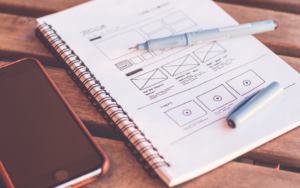
The User Interview is a qualitative, non-binary, open-ended process that is a crucial contextual inquiry research method. And creating a good questionnaire is like sharpening your weapon to make the best impact.
A well-prepared, well-rehearsed user questionnaire is a must for an insightful interview.
Why make a questionnaire before a User Interview?
To avoid Response Biases*!
Seven-eight response biases influence user interviews greatly; understanding the user persona objectively is crucial for good design decisions. A thorough understanding of the response biases will help you use them or avoid them to get functional responses from the user.
*Note: There will be an upcoming blog on Response Biases and how to use or avoid them in research. Keep following Mantra Labs’s blog posts.
To make interviews more relevant to the research goals:
Planning an interview questionnaire keeps the facilitator on track during interviews. What does this mean? Multiple probing questions are asked during any user interview to gain more information and a deeper understanding of the participant’s behavior. Due to the probing, three situations occur.
1. The facilitator gets carried away in probing and deviates from the central questions under the influence of the participant’s response.
2. The facilitator asks questions spontaneously under the influence of their biases that might not be relevant to the research goals.
3. There is a chance of losing track of interview goals and shifting off-topic. Sometimes it’s a good idea to check all the possibilities that could influence the user’s behavior. However, there should be a clear line at which to stop and come back to the main questions.
To make sure questions are open-ended and revised/reframed before interviews:
“Details are in the story,” and Open-ended questions allow participants to tell the story of their experience. Since participants’ responses should not be influenced or bound to respond in a certain way, it is crucial to plan open-ended questions.
E.g., a pet product company is researching the possibility of their product entering the market and developing some pet grooming products for millennial pet owners. Let’s look at some
questions to understand how open-ended they are.
Q 1: Would you use shampoo to make your dog smell better?
Q 1.1: What shampoo would you use to make your dog smell better?
Problem with these questions:
Q 1: It’s a Yes/No question that will not give any qualitative insights.
This question has little scope to know all the products the participant uses for grooming the dog.
Q 1.1: This is better than Q.1 because it has the scope of answering about shampoo products, but more is needed to know every detail of the pet cleaning-care habits of the user.
This can be a follow-up question to dig deeper, but not the main question.
What would be an excellent open-ended question?
Q. 1: What does your pet grooming process look like, and what products do you use while grooming?
Now this question has scope for the participant to tell the story of their pet’s grooming, including their process, the product they use, and how everything impacts their pet’s grooming pattern.
To avoid repetitive/similar questions:
If the questions still need to be pre-prepared and revised, the facilitator often asks questions similar to prior questions. This scenario causes a waste of time, sometimes irritating the participants as well.
To limit the number of questions and make them effective per the interview time limit.
- The time taken in an interview significantly impacts the qualitative information received from the participants. 40-45 minutes is the sweet spot for an interview. More than that, it starts becoming too much for the participant. If the facilitator continues to engage, the participant might get disengaged and be in a hurry to finish the interview.
- If it takes less than 40 minutes, you might not get a deep understanding of the question due to needing more probing in the response received from the participant.
How to make a good User Interview questionnaire?
Now that we know why, a good questionnaire is crucial before the research interview. There are some parameters and ways to write a good questionnaire.
Defining the business goal and user goal:
Keep stakeholder analysis as the first priority before writing the questionnaire. It’s crucial to know the business goals of the critical stakeholders to lay the foundation for your research interview. Also, try to understand and write the User Goal according to key stakeholders and their target personas.
Doing secondary research and gaining more information about the products, services, and business:
It helps the facilitator make questions more relevant to the topic. The planning of the questions would be about the product and the service, which would help to find impactful insights. Here are some matters to focus on while doing secondary research:
- Analytics of the website (whatever possible, Google Analytics, Hotjar, Similarweb), target personas, user journey, pain points, what are your most trafficked pages, which site pages rank high in SERPs, visits from organic sources, traffic referrals from other sites and channels, Traffic from direct URL into the search bar, Devices used by the traffic ETC.)
- Top performing keywords
- How long do people typically spend on your website?
- Page load time of the site?
- Competitors analysis
- User Personas
- Geolocations of major user bases
- Industry trends
- The existing research paper regards the context
- Existing customer journey map (If any)
Write the User Interview objective and key result properly:
This is the foundation of any research. Defining the OKR of the interview will keep your approach more constructive. The researcher should define why they are interviewing and what they want to achieve. Later, the questions should be formed in order to get the relevant information with regard to the interview objective.
The questions need to be framed in four categories that go in order one after another during the interview:
Intro Question and Ice Breakers
* Hi, How does your day/week go in Mantra Labs?
* Could you tell us about your role, followed by what your team does at Mantra Labs?
* How do you plan for your certain work to achieve your ‘X’ target?
Topic Specific Questions
* How do clients approach you and vice-versa?
* Could you describe a couple of scenarios where you failed to perform the task and how it happened?
* How do you overcome obstacles when performing such tasks?
Opportunity specific questions
* What is making a good impact on existing clients during the project?
Opinionated questions
* In your opinion, where would you suggest this service should improve?
Conclusion
User Interview Research in UX is crucial to making informed decisions to solve complicated problems for any product or service. As it is essential, it needs to be understood.
What does it mean? How should it be done? Also, when should it be done? But above all, the biggest problem with interviewers is a need for more technical and experiential knowledge of how to prepare Research Interview Questionnaires.
To do that, Interviews need to understand fundamental response biases, which can destroy the creation of the questionnaire and interview insights. Do thorough secondary research about the matter. Next, review the business goals and write the interview research goals and OKRs. And finally, have a structured questionnaire covering all types of questions.
About Author,
Vijendra is currently working as a Sr. UX Designer at Mantra Labs. He is passionate about UXR and Product Design.
- SEO Powered Content & PR Distribution. Get Amplified Today.
- PlatoData.Network Vertical Generative Ai. Empower Yourself. Access Here.
- PlatoAiStream. Web3 Intelligence. Knowledge Amplified. Access Here.
- PlatoESG. Automotive / EVs, Carbon, CleanTech, Energy, Environment, Solar, Waste Management. Access Here.
- BlockOffsets. Modernizing Environmental Offset Ownership. Access Here.
- Source: https://www.mantralabsglobal.com/how-to-prepare-user-interview-questionnaire/
- :has
- :is
- :not
- :where
- 1
- 40
- a
- About
- above
- According
- Achieve
- After
- All
- allow
- also
- an
- analysis
- analytics
- and
- Another
- any
- approach
- ARE
- AS
- At
- author
- avoid
- away
- back
- bar
- BE
- because
- becoming
- before
- BEST
- Better
- biases
- Biggest
- Blog
- Blog Posts
- Bound
- business
- but
- by
- CAN
- carried
- categories
- causes
- central
- certain
- Chance
- channels
- check
- clear
- clients
- come
- company
- complicated
- constructive
- contextual
- continues
- could
- Couple
- covering
- Creating
- creation
- critical
- crucial
- Currently
- customer
- Customer Journey
- decisions
- deep
- deeper
- defining
- describe
- Design
- Designer
- destroy
- detail
- developing
- Devices
- DIG
- direct
- do
- does
- Dog
- doing
- done
- due
- during
- Effective
- engage
- entering
- essential
- etc
- Every
- everything
- excellent
- existing
- experience
- experiential
- facilitator
- Failed
- Finally
- Find
- finish
- First
- Focus
- followed
- following
- For
- formed
- Foundation
- four
- from
- functional
- fundamental
- Gain
- gaining
- get
- Give
- Go
- goal
- Goals
- good
- Google Analytics
- greatly
- happened
- Have
- he
- help
- helps
- here
- hi
- High
- How
- How To
- However
- HTTPS
- ICE
- idea
- if
- Impact
- impactful
- Impacts
- improve
- in
- Including
- influence
- influenced
- information
- informed
- inquiry
- insightful
- insights
- Interview
- Interviews
- into
- IT
- journey
- journey map
- jpg
- Keep
- Key
- Know
- knowledge
- Labs
- later
- lay
- less
- like
- LIMIT
- Line
- little
- load
- Long
- Look
- look like
- losing
- Main
- major
- make
- Making
- Mantra
- Mantra Labs
- map
- Market
- Matter
- Matters
- max-width
- mean
- method
- might
- Millennial
- Minutes
- more
- most
- much
- multiple
- must
- Need
- needed
- needing
- needs
- next
- number
- objective
- obstacles
- of
- often
- on
- ONE
- Opinion
- or
- order
- organic
- Other
- Overcome
- owners
- Pain
- Paper
- parameters
- participants
- passionate
- Pattern
- People
- Perform
- performing
- plan
- planning
- plato
- Plato Data Intelligence
- PlatoData
- points
- possibilities
- possibility
- possible
- Posts
- Prepare
- Prior
- priority
- Problem
- problems
- process
- Product
- product design
- Products
- project
- properly
- qualitative
- question
- Questions
- received
- referrals
- regard
- regards
- relevant
- research
- researcher
- Respond
- response
- responses
- result
- review
- Role
- scenario
- scenarios
- scope
- Search
- secondary
- service
- Services
- SHIFTING
- should
- significantly
- similar
- Similarweb
- since
- site
- Sites
- situations
- SOLVE
- some
- Source
- Sources
- specific
- spend
- Spot
- stakeholder
- stakeholders
- starts
- Still
- Stop
- Story
- structured
- such
- suggest
- sweet
- taken
- takes
- Target
- Task
- tasks
- team
- Technical
- tell
- than
- that
- The
- their
- Them
- There.
- These
- they
- this
- three
- time
- to
- too
- topic
- track
- traffic
- try
- types
- typically
- under
- understand
- understanding
- understood
- upcoming
- URL
- us
- use
- used
- User
- user journey
- uses
- ux
- ux designer
- Visits
- want
- Waste
- Way..
- ways
- we
- Website
- WELL
- What
- What is
- whatever
- when
- which
- while
- why
- will
- with
- Work
- working
- would
- write
- writing
- You
- Your
- zephyrnet











